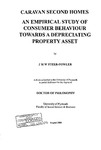Caravan second homes: an empirical study of consumer behaviour towards a depreciating property asset
| dc.contributor.supervisor | Megicks, Phil | |
| dc.contributor.author | Steer-Fowler, John Martyn William | |
| dc.contributor.other | Plymouth Business School | en_US |
| dc.date.accessioned | 2011-05-11T14:28:12Z | |
| dc.date.available | 2011-05-11T14:28:12Z | |
| dc.date.issued | 2009 | |
| dc.identifier | Not available | en_US |
| dc.identifier.uri | http://hdl.handle.net/10026.1/394 | |
| dc.description | Merged with duplicate record (10026.1/257) on 03.01.2017 by CS (TIS) | |
| dc.description | This is a digitised version of a thesis that was deposited in the University Library. If you are the author please contact PEARL Admin (pearladmin@plymouth.ac.uk) to discuss options. | |
| dc.description.abstract |
This research draws upon a combination of qualitative interviews and quantitative questionnaire data to investigate the role static caravans play within second home consumerism. Fundamentally it seeks to explain why people buy such a fast depreciating property asset. Results suggest how irrespective of their income two thirds of such consumers show a passionate loyalty towards their static caravan and have little regard for alternative forms of retreat they could afford. Clearly there are significant reasons beyond price which explain such investment. At their broadest static caravans proved to be desirable for reasons of escape, salvation, control, enhancement and opportunity but a number of further concepts began to emerge which extend current understanding of second homes. Within the caravan, space and time were found to hold greater value, and by virtue of their compactness life was considered to be organized, tidier, simplified and as a consequence more enjoyable than that at the principal home. Many of the alluring features which were inherent in their design were discovered to create an environment in which living was perceived to be miniaturised, adventuresome and a fairytale. Remarkably the lack of space and permanence were not perceived to be shortcomings but attributes, providing further forms of freedom and connection with nature. Purchases were seen to be driven as much by an attachment with the space static caravans provided, and memories of previous occasions enjoyed in them, as any desire for location. Through utilising chi-square tests with both factor and cluster analysis the research has been able to identify four types of consumer and the effects of eight statistically significant variables upon their profiles and behaviour. The character traits of purchasers were found to be particularly high in levels of agreeableness, and their perpetual yo-yoing between the caravan and home proved to be so regular, and the community they engendered so familiar, touristic characteristics were little evident. Indeed this research questions whether such consumption can continue to be considered touristic, and provides a fresh insight into understanding the need for a second home. Regardless of environment what purchasers yearned was a leisurely existence at home without any sense of guilt. What static caravans were found to provide was permissible behaviour; a utility within which `at leisure' could be transacted. For the first time this research quantifies the ownership of static caravan second homes and draws together a number of findings to explain the success they enjoy, to finally offer some resolve to the repeated calls for such study. | en_US |
| dc.language.iso | en | en_US |
| dc.publisher | University of Plymouth | en_US |
| dc.subject | Caravan | |
| dc.subject | Second homes | |
| dc.subject | Consumer Behaviour | |
| dc.subject | Tourism | |
| dc.title | Caravan second homes: an empirical study of consumer behaviour towards a depreciating property asset | en_US |
| dc.type | Thesis | |
| dc.identifier.doi | http://dx.doi.org/10.24382/3627 | |
| dc.identifier.doi | http://dx.doi.org/10.24382/3627 |
Files in this item
This item appears in the following Collection(s)
-
01 Research Theses Main Collection
Research Theses Main


